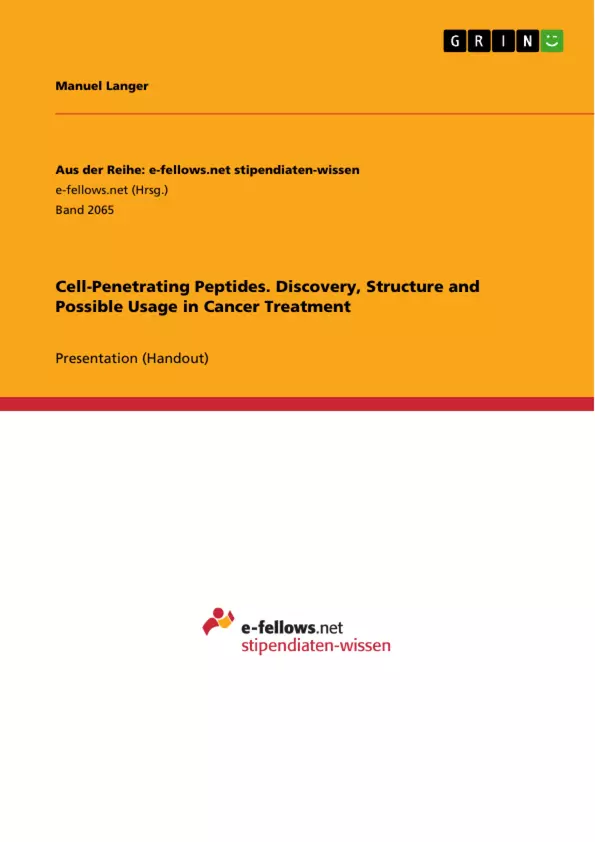This presentation is about cell penetrating peptides. It is briefly explained how they were discovered. The molecular mechanisms of the cell penetration are shown in detail. Furthermore, some examples for their usage are given, e.g. in combination with drugs like anti-tumor agents.
Inhaltsverzeichnis (Table of Contents)
- History
- Different Families of Cell-Penetrating Peptides (CPP's)
- Types of Cargo and Cargo attachement
- Mechanism of Uptake
- Potential Applications in Future Cancer Therapie
- Cell Targeting Peptides
- Activatable CPP's (ACCP)
- Transducible Agents of CPPs
- Summary
Zielsetzung und Themenschwerpunkte (Objectives and Key Themes)
This work explores the development, molecular mechanisms, and therapeutic applications of cell-penetrating peptides (CPPs). It aims to provide an overview of the field, covering the history of CPP research, different families of CPPs, cargo attachment strategies, mechanisms of uptake, and potential applications in cancer therapy.
- The discovery and development of CPPs
- The different families of CPPs and their properties
- The mechanisms of CPP uptake into cells
- The potential applications of CPPs in cancer therapy
- The limitations and challenges of CPP research
Zusammenfassung der Kapitel (Chapter Summaries)
The "History" section provides a chronological overview of key discoveries in CPP research, starting with the identification of the Tat protein from HIV-1 and the Antennapedia transcription factor. It highlights the development of the first CPP, penetratin, and the subsequent exploration of CPPs as delivery vehicles for various cargos.
The "Different Families of Cell-Penetrating Peptides (CPP's)" section defines CPPs as short peptides with the ability to enter cells independently of a membrane receptor. It classifies CPPs by their origin, cargo attachment strategies, and mechanisms of entry. This section presents a table of various CPPs, including their sequences, origins, and applications.
The "Types of Cargo and Cargo attachement" section discusses the different types of cargos that can be delivered by CPPs, such as nucleic acids, proteins, and small molecules. It outlines the two main strategies for cargo attachment: covalent and non-covalent. The advantages and disadvantages of each strategy are discussed.
The "Mechanism of Uptake" section explores the different pathways by which CPPs enter cells. It covers both endocytosis-mediated and direct translocation mechanisms, highlighting the complexity and variability of CPP uptake.
The "Potential Applications in Future Cancer Therapie" section presents several potential applications of CPPs in cancer therapy. It discusses the use of CPPs to target cancer cells selectively, activate CPPs specifically in cancer cells, and deliver therapeutic agents to cancer cells. This section highlights the potential of CPPs to improve cancer treatment outcomes.
Schlüsselwörter (Keywords)
Cell-penetrating peptides, CPPs, Tat protein, Antennapedia, penetratin, cargo delivery, endocytosis, direct translocation, cancer therapy, targeted delivery, activatable CPPs, transducible agents.
- Citar trabajo
- B. Sc. Manuel Langer (Autor), 2015, Cell-Penetrating Peptides. Discovery, Structure and Possible Usage in Cancer Treatment, Múnich, GRIN Verlag, https://www.grin.com/document/337837



